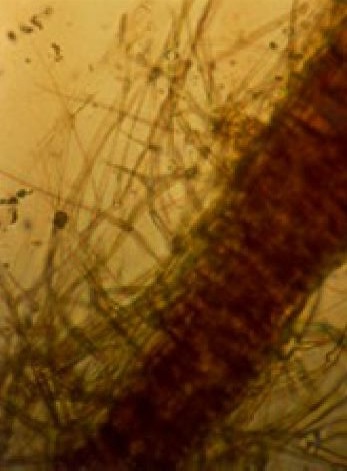 Texas Root Rot - June 17, 2015 Jeff Schalau, Agent, Agriculture & Natural Resources University of Arizona Cooperative Extension, Yavapai County Texas root rot (Phymatotrichopsis omnivora, previously named Phymatotrichum omnivorum), also known as cotton root rot, occurs throughout the southwestern United States and Mexico. It is present in the Verde Valley where it has been confirmed on many sites over the years. Most often, I have found it on fruit and nut trees. More recently, I’ve seen it on grape vines. In all cases, it was fatal to the host plant. Nevertheless, recognizing the symptoms and understanding what little we know about the disease could inform your future horticultural decisions. The symptoms of Texas root rot are somewhat distinctive. Plants infected with Texas root rot often wilt suddenly during the summer when temperatures are high. The dead or dying leaves usually remain attached to the plant. After the plant has died, the root system is decayed and brown. It is diagnosed by looking for fungal strands that are visible on the outer surfaces of the roots and under the root bark. Fungal spore mats may or may not be present on the soil surface near the infected plant. The mats appear off-white or tan and are level with the soil surface. These spores are not fertile and will not spread the disease. The species name, "omnivora", means omnivorous or "eats everything". This is not quite true, but almost. Texas root rot is a confirmed pathogen of over 2,300 plant species. Texas root rot most often shows a preference for fruit trees and broadleaf deciduous trees and shrubs. Infected fruit trees are most often noticed because we tend to monitor fruit crops during the growing season. It could also spread more easily in an orchard or vineyard because plants are usually closely planted. Texas root rot spreads by interwoven masses of fungal hyphae known as mycelia which colonize healthy root tissue. Once strands grow and colonize roots of a susceptible plant, the infection results in wilting and plant death. There is no effective treatment. In addition, there is no evidence to suggest that it can be carried to new sites by human activity or vehicles. It is in certain areas and stays there. Many native trees have some tolerance to Texas root rot. Somewhat tolerant species include mesquite, sycamore, desert willow, hackberry, as well as Gymnosperms, such as pine, spruce, cypress, and juniper. Interestingly enough, the only fruit that appears to have some tolerance is the pomegranate. Using the term “resistance” is relative – it can infect these plants, it is just not as common. Monocots (agaves, yuccas, grasses, palms, yuccas, bamboo, iris, lilies, gladiolus, onions, garlic, etc.) are totally resistant to Texas root rot. Some control measures have been recommended in the past, but subsequent research has proven these treatments ineffective. There is no test to determine the presence of Texas root rot in soil other than a dead plant that has been diagnosed by a trained individual. In other words, you can plant susceptible species and wait for them to display symptoms. As stated above, other root rots can display similar symptoms, so it is important to have the disease diagnosed by a knowledgeable person. Sampling a plant for Texas root rot is done by collecting dead roots and examining them under a dissecting microscope. If you suspect a plant has died from Texas root rot, collect several samples of rotting and discolored roots on which the outer or cortical tissue still remains attached. The samples should be pencil size or slightly larger and at least 6 inches long. Leave soil attached and keep the roots cool in a plastic bag (refrigeration is fine). Do not add water or wet paper towels. Submit the sample to one of the Yavapai County University of Arizona Cooperative Extension Offices. Our hours of operation are M-F 9 am to 4 pm. If you suspect Texas root rot, the best course of action is to collect a root sample and submit it for examination. Once a diagnosis has been made, remove the infected plant(s) and wait a full growing season before replanting. Resistant species make the best choices, but just as humans repopulate known flood plains following the floods, we will continue to replant susceptible species where we have had recent bouts with Texas root rot. Be sure to inspect suspected cases for other causes of similar symptoms such as gophers, chemicals, mechanical damage, or other root diseases. I have provided additional resources below. Follow the Backyard Gardener on Twitter – use the link on the BYG website. If you have other gardening questions, call the Master Gardener help line in the Camp Verde office at 928-554-8992 or e-mail us at verdevalleymg@gmail.com and be sure to include your name, address and phone number. Find past Backyard Gardener columns or provide feedback at the Backyard Gardener web site: http://cals.arizona.edu/yavapai/anr/hort/byg/. Additional Resources Cotton (Texas) Root Rot University of Arizona Cooperative Extension extension.arizona.edu/sites/extension.arizona.edu/files/pubs/az1150-2015.pdf Phymatotrichum Root Rot New Mexico State University Cooperative Extension aces.nmsu.edu/pubs/_a/A229/ |